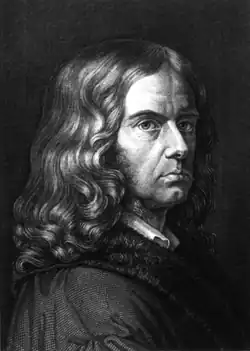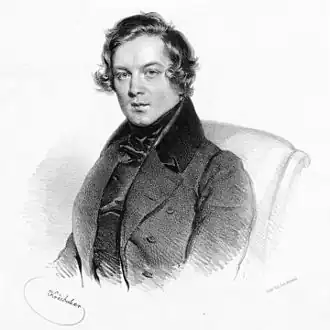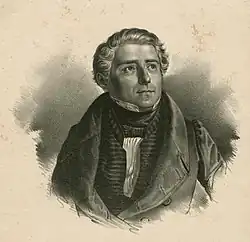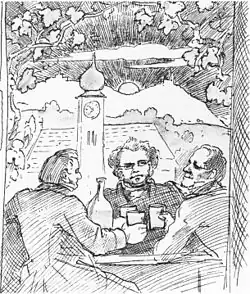Frauen-Liebe und Leben

Frauen-Liebe und Leben (A Woman's Love and Life) is a cycle of poems by Adelbert von Chamisso, written in 1830. They describe the course of a woman's love for her man, from her point of view, from first meeting through marriage to his death, and after. Selections were set to music as a song-cycle by masters of German Lied, namely Carl Loewe (1836), Franz Lachner (c1839), and Robert Schumann (1840). The setting by Schumann (his opus 42) is now the most widely known.
Chamisso's poems
There are nine lyrics in the cycle, to which Chamisso gave the title Frauen-Liebe und Leben. It was first published in 1830,[1] and twice in 1831 in the first editions of his poetry, and of his complete works.[2][3]
Schumann in his cycle did not set the final stanza of No. 2 ('Er, der Herrlichste von allen') with its sudden change of mood. He also left out the last poem, No. 9 'Traum der eignen Tage', which is addressed to the now aged protagonist's granddaughter ("Tochter meiner Tochter"). Loewe set all nine poems in full, although only the first seven were published together.
Nomenclature
The original published titles of the poem-cycle and the song-cycles are:
- Chamisso (1830): Frauen-Liebe und Leben
- Loewe (1836): Frauenliebe
- Lachner (c1839): Frauenliebe und -leben
- Schumann (1840): Frauenliebe und Leben
The Schumann work has been edited and published several times since 1840, and all the current reliable music publishers[4] still use the original 1840 published title, Frauenliebe und Leben, as do a majority of secondary sources discussing Schumann's song cycle.[5] However, Frauenliebe und -leben has been used in a minority (approximately one third) of recently published secondary sources,[6] and also on some LP and CD covers. This latter spelling is a 'correct' style of written German using the Ergänzungsstrich (i.e. suspended or hanging dash in a list of things),[7] although it does not accurately reflect the work's published title.
Schumann's setting

Schumann composed his setting Frauenliebe und Leben, Op. 42, in 1840, his "year of song" in which he wrote numerous lieder and three other complete song cycles: Liederkreis, Op. 24, Liederkreis, Op. 39 and Dichterliebe, Op. 48. There are eight poems in his cycle, together telling a story from the protagonist's first meeting her love, through their marriage, to his death. They are:
- 'Seit ich ihn gesehen' ("Since I saw him")
- 'Er, der Herrlichste von allen' ("He, the noblest of all")
- 'Ich kann's nicht fassen, nicht glauben' ("I cannot grasp or believe it")
- 'Du Ring an meinem Finger' ("You ring upon my finger")
- 'Helft mir, ihr Schwestern' ("Help me, sisters")
- 'Süßer Freund, du blickest mich verwundert an' ("Sweet friend, you gaze")
- 'An meinem Herzen, an meiner Brust' ("At my heart, at my breast")
- 'Nun hast du mir den ersten Schmerz getan' ("Now you have caused me pain for the first time")
The text mirrored Schumann's personal life at the time.[8] He had been courting Clara Wieck but had failed to get her father's permission to marry her. In 1840, after a legal battle to make such permission unnecessary, he finally married her. In 1838, Schumann compared Clara's father to a character in Chamisso's poetry.[9]
Schumann set Chamisso's poems on July 11 and 12, 1840.[10] His manuscripts are still extant. They mostly outline the voice part on single staves, with just a few bars of piano postlude at the very end of No. 8.[11]
Recordings
There have been many recordings of Schumann's setting.
Possibly the first was that of
- Julia Culp, with Otto Bake at the piano, for Odeon Records in Berlin in 1909: she later recorded it a second time.[12]
During the 1930s the principal versions were those of
- Lotte Lehmann (with salon orchestra accompaniment) (Parlophone-Odeon),
- Germaine Martinelli accompanied by Jean Doyen in French, (Columbia Records), and
- Emmy Bettendorf made a Parlophone Records set omitting two titles.[13]
- Lotte Lehmann made a later (wartime) recording with Bruno Walter at the piano (issued on LP by Philips Records as Minigroove ABL 3166).
- Elena Gerhardt made a recording with Gerald Moore in 1947–1948, which was privately published on White Label His Master's Voice, six sides, 12", 78rpm.[14]
Recordings by
- Astra Desmond (Decca 78rpm AK 1566–68) (with Phyllis Spurr, piano) and by
- Elisabeth Schumann with Gerald Moore. (His Master's Voice)
are noticed in 1951.[15]
- Kathleen Ferrier's version with John Newmark was issued on Decca Medium Play LW 5089.[16]
- Kathleen Ferrier's live recording with Bruno Walter at the Edinburgh Festival 1949, broadcast by the BBC and released in 1986 on Decca 414 611-1
- Christa Ludwig, accompanied by Gerald Moore, recorded in 1959 on EMI.
- Lillian 'Windsor' Winzig, recorded performance at Carnegie Hall, February 19, 1954.
- Kirsten Flagstad, accompanied by Edwin McArthur appeared on His Master's Voice ALP 1191 by 1955.[17]
- Erna Berger, accompanied by Scherzer (His Master's Voice ALP 1587) issued 1958.[18]
- Irmgard Seefried, accompanied by Erik Werba (Deutsche-Grammophon LPEM 19112) rec. 1957.[19]
- Leontyne Price, accompanied by David Garvey, issued 1970, on RCA LSC-3169
- Edith Mathis, accompanied by Christoph Eschenbach, issued 1981, on DGG LP 2562 400 in set 2740 266.
These recordings are listed on CD in 1996:[20]
- Janet Baker with Martin Isepp (Saga CD EC 3361-2), 1960s.
- Janet Baker with Daniel Barenboim (His Master's Voice LP ASD 3217), issued 1976.
- Brigitte Fassbaender accompanied by Irwin Gage. (DG 439 417-2).
- Anne Sofie von Otter with Bengt Forsberg. (DG DIG 445 881-2).
- Sarah Connolly with Eugene Asti. (Chandos B001FENY80).
- Elīna Garanča with Malcolm Martineau. (DG 483 9210), November 2020.
Loewe's setting

Carl Loewe's Frauenliebe, for mezzo-soprano and piano, was published as his opus 60 in 1836.[21] He called it a Liederkranz ('wreath [or garland] of songs'), rather than a Liederkreis ('song-cycle').
Although Loewe set all nine of Chamisso's poems in September 1836, only the first seven were published together during his lifetime.[21]: vii [22] No. 9, 'Traum der eignen Tage', was published separately in 1869, and No. 8 remained in MS until 1904 when it was included in the Breitkopf & Härtel complete edition of his works.[21]: 56ff
Recordings
- Brigitte Fassbaender, mezzo-soprano; Cord Garben, piano (DGG DG 423 680-2)
- Callista Huffman, mezzo-soprano; Giorgi Latsabidze, piano (USC NCH 511-10)
Lachner's setting

Around 1839, Franz Lachner set Frauenliebe und -leben for soprano, horn or cello, and piano as his Op. 59. He made another arrangement for soprano, clarinet, and piano. It was published in 1847 as his Op. 82.[23]
Like Schubert's Auf dem Strom, D. 943, it is part of the small repertoire of solo vocal music ensemble with horn. Lachner's youngest brother, Vincenz Lachner, wrote a song 'Waldhornruf' (Hunting horn call') for tenor, horn and piano.[24]
Recordings
- Evelyn Tubb (soprano), Lesley Schatzberger (clarinet), Richard Burnett (fortepiano) – Classicprint CPV005CD.
- Aríon Trio (Andrea Weigt, soprano; Stefan Henke, horn; Rainer Gepp, piano), Antes Edition BM CD 31.9120.
References
- ^ Hallmark, Rufus (2014). Frauenliebe und Leben: Chamisso's Poems and Schumann's Songs. Music in Context. Cambridge University Press. p. 111. ISBN 9781107002302.
- ^ Complete modern text: Chamisso, Adelbert von. "Frauen-Liebe und Leben" (in German). Zeno.org. Retrieved 1 September 2017.
- ^ Chamisso, Adelbert von (1831). Gedichte von Adelbert von Chamisso (in German). Leipzig: Weidmann'sche Buchhandlung. pp. 11–22. NB Set in Fraktur (Gothic) type.
- ^ The list as of January 2020 includes Breitkopf und Härtel, Edition Peters (Urtext edition), Bärenreiter, G. Henle Verlag, and Universal Edition. The Peters 'old edition' used Frauen-Liebe und Leben, and a modern reprint of that edition uses Frauenliebe und -leben.
- ^ a b See this article's talk page.
- ^ See search on WorldCat for "Schumann, Robert, 1810–1856. Frauenliebe und Leben" and.[5]
- ^ "Ergänzungsstrich". BeoLingus. Retrieved 11 December 2017. See also de:Viertelgeviertstrich#Ergänzungsstrich on German Wikipedia.
- ^ Sams, Eric. The Songs of Robert Schumann. Faber & Faber, 2011. 128f.
- ^ Schumann, Clara, and Schumann, Robert. The Complete Correspondence of Clara and Robert Schumann. Austria, P. Lang, 1994. 205.
- ^ Daverio, John. Robert Schumann: Herald of a "New Poetic Age". Oxford University Press, USA, 1997. 194.
- ^ "Music Manuscripts Online: Frauenliebe und Leben (Sketches)". The Morgan Library and Museum. 23 January 2014. Retrieved 1 September 2017. NB Select 'Zoom view', to change pages use the l.h. menu and click on 'fol. 1v', 'fol. 2r' (verso/recto) etc.
- ^ Reissued on LP, His Master's Voice Treasury RLS 1547003, with booklet by Leo Riemens and William Mann, 1983.
- ^ R. D. Darrell, The Gramophone Shop Encyclopedia of Recorded Music (New York 1936).
- ^ E. Gerhardt, Recital (Methuen, London 1953), 180.
- ^ E. Sackville-West and D. Shawe-Taylor, The Record Year (Collins, London 1951), 538.
- ^ EMG Review January 1951. EMG, The Art of Record Buying 1960 (EMG, London 1960).
- ^ A Complete List of His Master's Voice, Columbia, Parlophone and MGM Long Playing records up to June 1955 (EMI, London 1955).
- ^ EMG Review July 1958. EMG, The Art of Record Buying 1960 (EMG, London 1960).
- ^ EMG Review June 1958. EMG, The Art of Record Buying 1960 (EMG, London 1960).
- ^ I. March, E. Greenfield and R. Layton, Penguin Guide to Compact Discs (Harmondsworth 1996 edition)
- ^ a b c Loewe, Carl (1904). "Frauenliebe : Liederkranz von Adalbert von Chamisso". In Runze, Max (ed.). Carl Loewes Werke, Band XVII: Liederkreise. Gesamtausgabe der Balladen, Legenden, Lieder und Gesänge (in German). Leipzig: Breitkopf & Härtel. pp. 32–60. Retrieved 31 August 2017.
- ^ e.g. Loewe, Carl (n.d.) [1837]. Frauenliebe : Liederkranz von Adalbert von Chamisso. Berlin: H. Wagenführ. OCLC 67186316.
{{cite book}}: CS1 maint: year (link) - ^ "Frauenliebe und -leben, Op 82: Introduction". Hyperion. Retrieved 1 September 2017.
- ^ Lachner, Vincenz. Waldhornruf. Badische Landes-bibliothek (BLB) (in German). Retrieved 1 September 2017.
Further reading
- Ingo Müller: "Eins in Allem und Alles in Einem: Zur Ästhetik von Gedicht- und Liederzyklus im Lichte romantischer Universalpoesie". In: Günter Schnitzler und Achim Aurnhammer (Hrsg.): Wort und Ton. Freiburg i. Br. 2011 (= Rombach Wissenschaften: Reihe Litterae. vol. 173), pp. 243–274.
External links
- Chamisso, Adelbert von. Gesammelte Werke, Erster Band. Germany, Cotta, 1880.
- "Frauen-Liebe und Leben", pp. 191–7.
- Frauenliebe und -leben, Op. 42 (Schumann): Scores at the International Music Score Library Project
- Texts of the Schumann cycle. lieder.net
- Loewe's Frauenliebe is contained in his complete Liederkreise: Scores at the International Music Score Library Project
- Text of No. 9 of the Loewe cycle, lieder.net
- Chamisso's autograph MS of No. 4, plus covers of two early Schumann editions